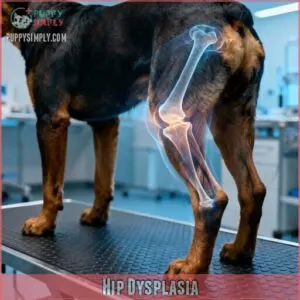This site is supported by our readers. We may earn a commission, at no cost to you, if you purchase through links.
 A Rottweiler owner recently asked me when she should spay her dog. She’d heard "six months" from one vet, "wait until two years" from a breeder, and found a dozen conflicting answers online. Her confusion isn’t surprising—the timing of neutering has become one of the most debated topics in veterinary medicine, particularly for large breeds like Rottweilers.
A Rottweiler owner recently asked me when she should spay her dog. She’d heard "six months" from one vet, "wait until two years" from a breeder, and found a dozen conflicting answers online. Her confusion isn’t surprising—the timing of neutering has become one of the most debated topics in veterinary medicine, particularly for large breeds like Rottweilers.
Research now shows that the "one size fits all" approach to sterilization doesn’t account for breed-specific health risks. For Rottweilers, neutering too early can increase their vulnerability to bone cancer, joint disorders, and urinary problems—conditions that can shorten their lifespan by more than a year. Understanding the science behind these risks helps you make an informed decision that protects your dog’s long-term health.
Table Of Contents
- Key Takeaways
- Increased Cancer Risk
- Orthopedic Problems
- Urinary Incontinence
- Longevity and Health
- Alternatives to Early Neutering
- Frequently Asked Questions (FAQs)
- When should I spay or neuter a Rottweiler?
- Should you neuter a Rottweiler?
- When should you neuter a Yorkie or a Rottweiler?
- Does neutering a Rottweiler affect growth?
- Can spaying or neutering a Rottweiler change your personality?
- When should you neuter a dog?
- Will neutering change my Rottweiler’s personality?
- What is the cost to neuter a Rottweiler?
- Can neutering help with aggression issues in Rottweilers?
- What behavioral changes occur after neutering a Rottweiler?
- Conclusion
Key Takeaways
- Wait until at least 24 months before neutering your Rottweiler to allow full skeletal maturity, which significantly reduces risks of bone cancer (osteosarcoma), joint problems like ACL tears and hip dysplasia, and can prevent a lifespan reduction of 1-1.5 years seen with early neutering.
- Early neutering before 12 months dramatically increases health risks specific to Rottweilers, including a 70% higher rate of hip dysplasia, over 25% bone cancer risk, and five times greater hemangiosarcoma risk compared to dogs neutered after full maturity.
- Female Rottweilers spayed too early face increased urinary incontinence due to hormonal changes weakening the urinary sphincter, while those who retain their ovaries beyond 4.2 years live an average of 17 months longer.
- Consider hormone-preserving alternatives like vasectomy for males or ovary-sparing spay for females, which prevent pregnancy while maintaining the natural hormones crucial for healthy bone growth and cancer protection in this breed.
Increased Cancer Risk
Early neutering in Rottweilers has been linked to a higher risk of certain cancers, particularly when the procedure is done before full physical maturity. The timing of neutering can influence your dog’s long-term health, making it critical to understand which cancers show increased rates.
Let’s look at the specific cancer risks associated with early neutering.
Bone Cancer
When you neuter your Rottweiler too early, you’re opening the door to osteosarcoma—a devastating bone cancer that disproportionately affects this breed. Early neutering disrupts growth plates before they close, interfering with hormones that protect against cancer development. Cancer research shows Rottweilers neutered before maturity face considerably elevated risks, with breed predisposition making timing critical. This painful condition involves considerable destruction of bone tissue.
Protect your dog by:
- Waiting until at least 24 months before neutering
- Monitoring for limping or bone swelling between ages 5-8
- Discussing hormone-preserving alternatives like vasectomies with your vet
These orthopedic and health risks aren’t worth rushing the procedure.
Other Cancers
Beyond bone cancer, early neutering increases your Rottweiler’s risk of hemangiosarcoma and mast cell tumors. Cancer research shows breed-specific vulnerabilities: hemangiosarcoma risk jumps five times higher in spayed or neutered dogs, while mast cell tumors double. These breed predispositions stem from removing sex hormones before maturity. Lymphoma risk also climbs when timing’s wrong.
Waiting until 24 months aids cancer prevention by letting hormones protect against these cancers naturally. Spaying and neutering can also reduce unwanted breeding.
Orthopedic Problems
Early neutering doesn’t just affect cancer risk—it can also impact your Rottweiler’s skeletal development in ways that last a lifetime. When growth plates close prematurely due to hormonal changes, your dog becomes more vulnerable to joint and bone problems.
Let’s look at two of the most common orthopedic issues linked to early neutering.
ACL Injuries
Among orthopedic problems, ACL injuries stand out as a critical concern for your Rottweiler. Research shows Rottweilers face 3.66 times greater risk of cranial cruciate ligament rupture compared to crossbreeds, and early neutering before 24 months dramatically increases this risk. In fact, over 40% of injuries in early-neutered dogs are cruciate ligament tears. Neutering age matters because removing reproductive hormones too soon disrupts normal bone growth, altering joint angles and placing extra stress on the ligament.
This isn’t just about one surgical intervention—bilateral ruptures affect both knees in susceptible breeds, leading to prolonged post-op recovery spanning 8–12 weeks per leg.
To protect your Rottweiler’s joints:
- Wait until at least 24 months before neutering to allow proper skeletal development.
- Maintain ideal body weight through diet and conditioning exercises.
- Discuss genetic factors with your vet to assess individual risk.
Delaying sterilization gives bones and joints time to mature properly, reducing your dog’s likelihood of facing costly joint disorders down the road.
Hip Dysplasia
Your Rottweiler’s genetic predisposition makes hip dysplasia a serious threat—41% to 69% of the breed shows radiographic signs of this joint disorder. Early neutering before 12 months increases hip dysplasia risk by 70% because removing reproductive hormones disrupts normal joint development. Sex hormones regulate bone growth until growth plates close around 18 months, and premature sterilization causes abnormal bone proportions that stress the hip socket.
| Risk Factor | Impact on Hip Dysplasia |
|---|---|
| Early neutering (before 5.5 months) | 70% increased risk versus later sterilization |
| Genetic predisposition | Rottweilers rank among breeds with highest heritable risk |
| Environmental factors (rapid growth, obesity) | Accelerates joint stress and degenerative changes |
Disease progression leads to osteoarthritis, lameness, and reduced mobility. Waiting until 24 months for neutering protects joint health during critical skeletal maturation.
Urinary Incontinence
One of the less-discussed but surprisingly common issues linked to spaying is urinary incontinence, especially when the procedure happens too early. When you spay female Rottweilers before maturity, hormonal changes can weaken the urinary sphincter, causing involuntary urine leakage. This long-term health concern often appears years after the procedure.
Risk Factors for Urinary Incontinence:
- Early neutering before 12 months markedly increases risk
- Larger breeds like Rottweilers face higher susceptibility
- Obesity and aging compound existing health risks
- Hormonal deficiency disrupts bladder control mechanisms
Diagnosis and Treatment involve veterinary examination and may include medication or surgical management options.
Longevity and Health
When considering the best age to neuter Rottweiler dogs, lifespan impact becomes a critical factor that often surprises owners. Unlike most breeds where neutering extends life, Rottweilers show breed specificity with opposite results. Male Rottweilers neutered before one year live 1.5 years shorter than intact males, while females spayed before one year lose about one year of lifespan. This data analysis comes from tracking over 7,000 Rottweilers, revealing that ideal timing matters greatly for longevity and health of Rottweilers.
Unlike most breeds, neutering Rottweilers before one year shortens their lifespan by up to 1.5 years compared to intact dogs
The mortality factors center on cancer risks in Rottweilers, particularly bone sarcoma. Health risks of early sterilization include bone cancer rates exceeding 25% in dogs neutered before age one, compared to 7.6% in those neutered after 3.5 years. Female Rottweilers with ovary exposure beyond 4.2 years live 17 months longer on average. Your vet can help determine timing that balances these Rottweiler health concerns against behavioral and reproductive considerations.
Alternatives to Early Neutering
If you’re worried about neutering your Rottweiler too early, you’re not alone—and you do have options.
Some procedures let your dog keep their hormones while preventing pregnancy, and others offer temporary solutions.
Here’s what you should know about three alternatives.
Vasectomy
If you’re looking for alternatives to spaying/neutering your Rottweiler, a vasectomy lets your male dog keep his hormones while preventing unwanted litters. This procedure removes a section of the vas deferens, blocking sperm without touching the testicles. Recovery time is usually faster than traditional neutering, and it confronts concerns about early hormone removal in large breeds like Rottweilers.
- Highly effective at preventing pregnancy without compromising natural development
- Preserves testosterone for healthy bone growth and muscle development
- Faster recovery with less invasive surgical technique
- Minimal behavioral impact compared to full castration
- Reduces health risks linked to premature hormone loss in Rottweilers
Ovary-Sparings Spay
For female Rottweilers, an ovary-sparing spay (OSS) removes the uterus while preserving the ovaries, allowing hormone retention that aids healthy bone development and reduces cancer risks linked to early spaying. This surgical technique prevents pregnancy and eliminates uterine infections while maintaining natural estrogen levels.
OSS benefits include longer lifespan potential and fewer orthopedic problems, though you’ll need to monitor for heat cycles. Consult your veterinarian about whether this alternative suits your Rottweiler’s specific health profile.
Birth Control
If you’re not ready to commit to surgical sterilization, canine birth control methods offer temporary pregnancy prevention while preserving your Rottweiler’s hormones and fertility. These alternative methods provide flexibility while you monitor your dog’s development:
- Progestin injections suppress estrus cycles without permanent effects
- GnRH agonist implants temporarily suspend ovulation and breeding capability
- DES (diethylstilbestrol) treatments inhibit heat cycles in female Rottweilers
- Hormone replacement therapy maintains beneficial hormonal influence after sterilization
Research on canine birth control continues evolving, so veterinary consultation remains essential for preventing pregnancy and unwanted litters safely.
Frequently Asked Questions (FAQs)
When should I spay or neuter a Rottweiler?
Rottweilers need proper bone and hormonal development before neutering. The best age for spaying/neutering is 24 months to minimize cancer risks and orthopedic problems in Rottweilers.
Breed-specific guidelines emphasize waiting until growth plates close, which considers the behavioral impact while following ethical concerns around premature procedures.
Should you neuter a Rottweiler?
Neutering your Rottweiler isn’t mandatory, but it offers significant health benefits and fosters owner responsibility. Breed-specific cancer risks decrease with proper timing, though behavior changes and weight management require attention post-procedure.
When should you neuter a Yorkie or a Rottweiler?
Breed considerations matter when timing neutering. For Yorkies, you can safely neuter at six to twelve months.
But Rottweilers need to wait until at least twenty-four months to minimize cancer risks and orthopedic problems from early spaying/neutering.
Does neutering a Rottweiler affect growth?
Think of a house under construction—you wouldn’t pull the support beams before the walls are up. Early neutering removes hormones that tell growth plates when to close, which affects growth in Rottweilers. This can result in longer bones, reduced bone density, delayed muscle development, and an increased risk of joint disorders and orthopedic problems.
Can spaying or neutering a Rottweiler change your personality?
Yes, spaying or neutering can cause behavioral changes in your Rottweiler. Hormones influence dog behavior, so removing reproductive organs often reduces aggressive behavior, roaming, and urine marking. However, temperament shifts vary by individual, and training impact remains essential.
When should you neuter a dog?
For most dogs, the ideal neutering age is between six to twelve months. However, breed-specific neutering recommendations matter—large breeds like Rottweilers benefit from waiting until at least 24 months to minimize cancer risks and orthopedic problems.
Will neutering change my Rottweiler’s personality?
Your Rottweiler’s core personality—loyalty, protectiveness, playfulness—won’t vanish after neutering. However, testosterone-driven behaviors like roaming, urine marking, and some forms of aggression may decrease.
Training and socialization shape temperament far more than hormones ever will, so focus your energy there.
What is the cost to neuter a Rottweiler?
Neutering a Rottweiler usually costs between $200 and $800, depending on geographic variation, veterinarian fees, and your dog’s size. Additional fees for pre-surgical bloodwork or pain medication may apply.
Many dog owners use payment plans or insurance coverage to manage procedure costs.
Can neutering help with aggression issues in Rottweilers?
Aggression isn’t a switch testosterone alone controls—it’s more like a knot woven from genetics, environment, and experience. Neutering may dampen territorial marking and roaming in Rottweilers, but aggressive behaviors rooted in fear or poor socialization won’t disappear.
Pair the procedure with professional training and behavioral modification for real results.
What behavioral changes occur after neutering a Rottweiler?
After neutering, you’ll likely notice reduced aggression and roaming behaviors as testosterone levels drop. Energy changes vary—some dogs mellow out, while trainability often improves.
Behavioral problems like marking decrease, though anxiety levels and social behavior depend on individual temperament and timing.
Conclusion
Just as your Rottweiler’s breeder and vet gave conflicting advice, the science itself reveals a similar tension between tradition and evidence. Determining the best age to neuter a Rottweiler requires weighing cancer risks, joint health, and urinary function against your dog’s individual circumstances.
The research consistently points toward waiting until skeletal maturity—around 18 to 24 months—to minimize orthopedic problems and osteosarcoma risk.
Discuss alternatives like vasectomy or ovary-sparing procedures with your veterinarian if breeding prevention is your primary concern. Your decision shapes your dog’s health for years to come.
- https://www.frontiersin.org/articles/10.3389/fvets.2024.1322276/full
- https://journals.plos.org/plosone/article?id=10.1371/journal.pone.0055937
- https://avmajournals.avma.org/view/journals/javma/224/3/javma.2004.224.380.xml
- https://www.canadianveterinarians.net/documents/spaying-and-neutering
- https://pmc.ncbi.nlm.nih.gov/articles/PMC8818196/











